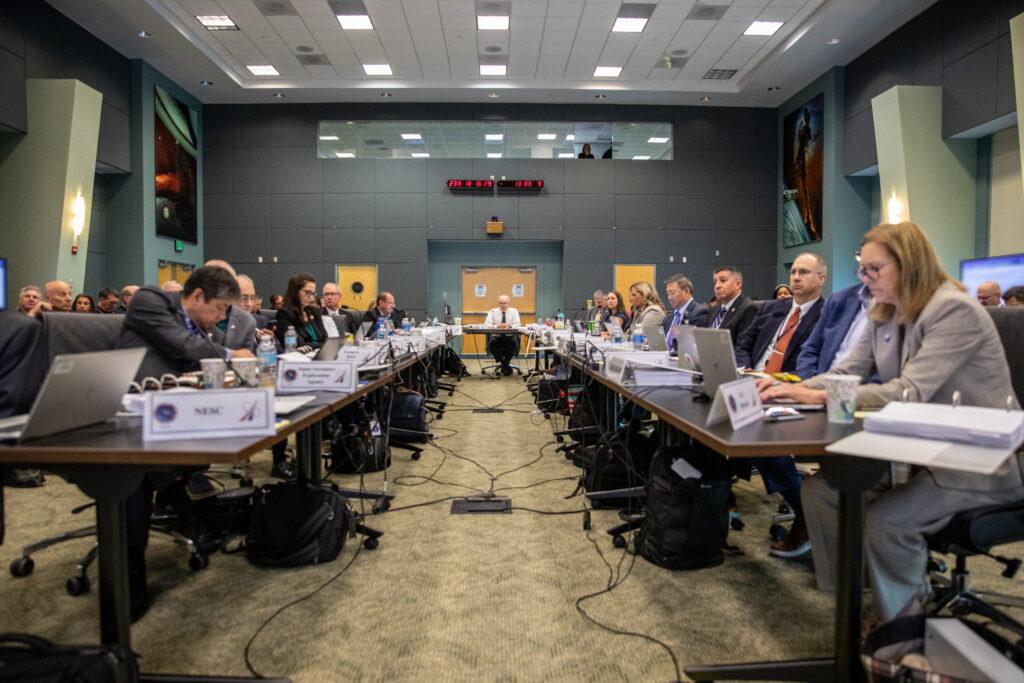
NASA hosts a Flight Readiness Review for the Aug. 25 Crew-7 launch.
HOUSTON—Preparations continue for the planned Aug. 25 launch of NASA’s Crew-7’s three astronauts and a cosmonaut to the International Space Station (ISS) to begin a multi-mission exchange of the seven current crewmembers.
Early Aug. 22, the Crew-7 members wrapped up a countdown dress rehearsal aboard their SpaceX Dragon Endurance capsule at Kennedy Space Center’s Launch Complex 39B in which their Falcon 9 rocket was loaded with propellant for a six-second test firing of its core stage. The crewmembers are: NASA’s Jasmin Moghbeli, the Crew-7 commander; the European Space Agency’s Andreas Mogensen, the pilot; and mission specialists Satoshi Furukawa of the Japan Aerospace Exploration Agency and Konstantin Borisov of the Russian space agency.
Both milestones followed a 7-hr. Flight Readiness Review (FRR) on Aug. 21 that concluded with a unanimous “go” for launch, according to Ken Bowersox, NASA’s Space Operations Mission Directorate associate administrator, speaking to a post-review news briefing.
The Aug. 25 launch is planned for 3:49 a.m. EDT and will lead to an automated docking of the Endurance capsule with the space-facing port of the station’s U.S. Harmony module on Aug. 26 at 2:02 a.m. EDT, the start of a six-month mission for Moghbeli, Mogensen, Furukawa and Borisov.
They will arrive trained to participate in and oversee about 300 experiments and technology demonstrations, 81 of them new.
The estimated first five or so days of their ISS stay will be focused on handover of operations with NASA’s Crew-6 Endeavour astronauts—NASA’s Steve Bowen and Woody Hoburg, United Arab Emirates astronaut Sultan Alneyadi and Russian cosmonaut Andrey Fedyaev. They launched on March 2 and are to return aboard their Dragon Endeavour capsule with a parachute-assisted splashdown off Florida once the handover is complete.
The SpaceX Dragon Endurance Crew-7 capsule has launched twice previously with astronauts bound for the ISS.
During the FRR, Bowersox and his colleagues addressed a Dragon liquid-oxygen propellant valve corrosion issue that surfaced in June during SpaceX’s 28th NASA-contracted resupply mission to the ISS. The valve, which stuck closed, was removed for analysis once the Dragon cargo capsule splashed down.
Over several weeks, the corrosion was traced to a mix of vapor from the flow of liquid-oxygen propellant and small amounts of moisture, although the materials composing the valves themselves are corrosion-resistant, NASA Commercial Crew program manager Steve Stich told the news briefing. Some of the valve components on Endurance then were replaced or remediated to address the concern.
SpaceX’s assessment also revealed that if activated for an additional period of time, the valves can push through the corrosion to reach their desired configuration, according to Bill Gerstenmaier, the company’s vice president for build and flight reliability.
Another issue addressed during the FRR was the Dragon’s parachute system, which is essential for slowing the crew capsule during its descent to Earth. When SpaceX’s Crew-5 Dragon capsule with four astronauts returned to Earth on March 11, the second of the two drogue parachutes that deploy to pull out the four main parachutes took several seconds longer than expected to fully inflate. NASA and SpaceX assessed the response independently with modeling and testing prior to clearing the system for the return of Crew-6 as well as the Crew-7 launch, while acknowledging parachute performance must be monitored closely, according to Stich.
The upcoming ISS crew exchange will require more than the launch of Crew-7 and return of Crew-6.
NASA astronaut Frank Rubio launched with cosmonauts Sergey Prokopyev, the station’s current commander, and Dmitri Petelin aboard the Soyuz MS-22 on Sept. 21, 2022. In mid-December, MS-22 experienced an external coolant leak while docked to the ISS that led to an uncrewed deorbit of the capsule on March 28.
The MS-22 was replaced with the launch of the also uncrewed Soyuz MS-23 in late February and it was decided to delay the launch of a replacement threesome—cosmonauts Oleg Kononenko and Nikolai Chub and NASA astronaut Loral O’Hara—until Sept. 15. Their docking to the ISS will lead to a planned Sept. 27 return to Earth of the MS-23 with Rubio, Prokopyev and Petelin.
Rubio’s 371-day mission will be the longest by an American astronaut, breaking the 355-day record set by NASA astronaut Mark Vande Hei upon his return to Earth from the ISS on March 30, 2022.





